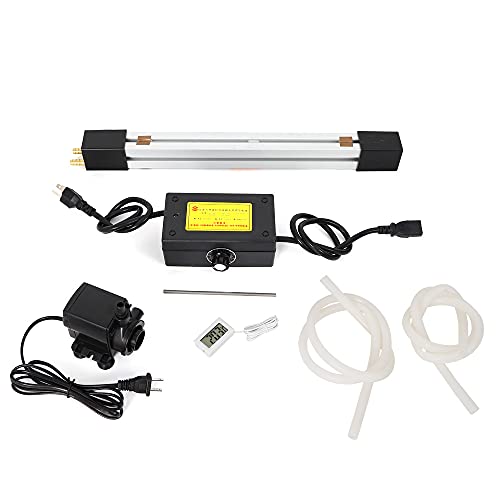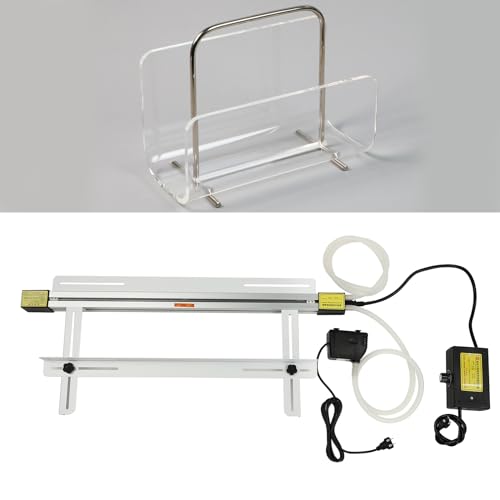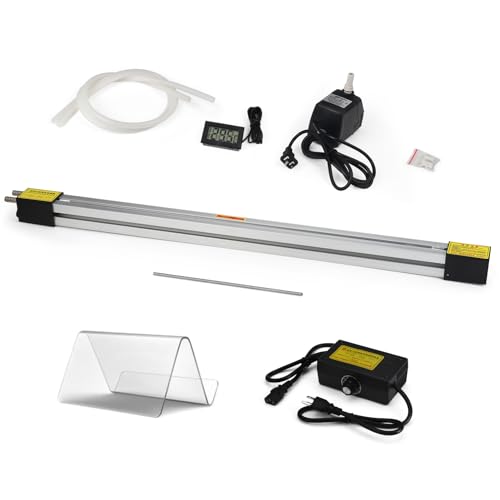Plastic strip heaters, often used for bending acrylic, PVC, and other thermoplastics, come in varied lengths, power levels, and cooling systems. Below is a compact summary of top options selected for performance, build, and feature set to help you compare quickly.
| Product | Length / Power | Key Feature |
|---|---|---|
| 12″ 300mm Acrylic Plastic PVC Bending Machine (LOYALHEARTDY) | 12″ / 300W | Water Circulation Cooling, Adjustable Temp |
| 110V Acrylic Bender 300mm 12in (Generic) | 12″ / 300W | Thermostat Temperature Control, Water Cooling |
| NeNchengLi 24″ Acrylic PVC Plastic Bender | 24″ / 1000W | High Power, Digital Thermometer, Adjustable Bracket |
| 24″ Portable Acrylic Plastic PVC Bending Machine (Gdrasuya10) | 23″ / 800W | Dual-Heater Option, Built-In Water Cooling |
| Oztwel 23.6″ Acrylic PVC Plastic Bender | 23.6″ / 800W | Aluminum Extrusion Body, Temp Gauge & Water Cooling |
Content Navigation
- 12in Acrylic Plastic Bender
- 12in Acrylic Bender With Thermostat
- 24in High Power Acrylic Bender
- 23in Portable PVC Bending Machine
- 23.6in Aluminum-Body Strip Heater
- Buying Guide: Choosing The Right Plastic Strip Heater
- Workpiece Size And Heater Length
- Power And Heating Speed
- Temperature Control And Monitoring
- Cooling System And Heat Isolation
- Material Compatibility And Thickness Range
- Construction And Durability
- Portability Versus Fixed Setup
- Heating Configuration: Single vs Dual Heater
- Safety Features
- Use Case Comparisons
- Maintenance And Consumables
- Multiple-Unit Strategies
- Final Compatibility Checklist
12in Acrylic Plastic Bender

This 12″ acrylic bender from LOYALHEARTDY is designed for small to mid-size acrylic and PVC workpieces. The unit features a water circulation cooling system on both sides of the heating tube to confine heat to the intended bend line and reduce unwanted thermal deformation. The temperature is adjustable, providing more control when working across thicknesses from 1mm to 6mm. The compact footprint suits hobbyists, sign makers, and small fabricators who need a portable strip heater with focused heating.
12in Acrylic Bender With Thermostat

This 12in model labeled Generic emphasizes ease of temperature control via a thermostat and targets the same material range—acrylic, organic board, PVC, and similar thermoplastics up to 6mm thick. The design highlights a uniform heating length of 300mm and a safety-focused water cooling setup. The thermostat enables repeatable bend conditions and is suitable for users who prioritize consistent temperature management for repeated parts.
24in High Power Acrylic Bender

Call 888-896-7031 for Free Local HVAC Quotes – Compare and Save Today!
The NeNchengLi 24″ bender is targeted at higher throughput tasks and thicker or larger parts. With a stated power rating of 1000W and a high-quality heating wire, it supports faster, broader heating. The unit includes a digital thermometer for real-time monitoring and an adjustable bracket to secure larger workpieces during bending. Like other models here, it uses water cooling at the tube ends to limit heat spread. This model is appropriate where speed and a longer heating span are required.
23in Portable PVC Bending Machine

The Gdrasuya10 23″ bender emphasizes portability and flexibility. It features dual heaters enabling simultaneous top-and-bottom heating, which can help achieve cleaner bends in thicker sheets or slot-bend techniques. The product description highlights a built-in circulating water cooling system and the ability to combine multiple units for multi-point heating. This configuration suits workshops where modular setups or varied bending points are common.
23.6in Aluminum-Body Strip Heater

The Oztwel 23.6″ acrylic bender combines an aluminum extrusion body with an 800W heating tube designed to heat quickly and evenly across a larger span. The package calls out a water cooling system and a temperature meter to monitor water temperature in real time—useful for maintaining consistent bending conditions. Recommended for users working with sheets up to 6mm thick, its extruded body can offer improved rigidity and heat dissipation compared to sheet-metal constructions.
Buying Guide: Choosing The Right Plastic Strip Heater
Selecting a plastic strip heater involves evaluating several interrelated factors. Below are the key considerations to weigh before purchase, organized to help match the tool to your application.
Call 888-896-7031 for Free Local HVAC Quotes – Compare and Save Today!
Workpiece Size And Heater Length
Match the heater length to the maximum bend length you need. 12″ (300mm) units suit small signs and trims, while 23–24″ heaters accommodate wide bends or fewer passes. Longer heaters reduce multiple heating cycles for large panels.
Power And Heating Speed
Power rating affects how quickly the heating wire reaches working temperature and how evenly it heats across the length. Higher wattage units (e.g., 800–1000W) heat faster and are better for thicker plastics; lower wattage suits thinner materials and light-duty use.
Temperature Control And Monitoring
Thermostats or digital controls offer repeatable settings. A temperature gauge or digital thermometer helps maintain consistent bend quality, especially when producing multiple identical parts.
Cooling System And Heat Isolation
Built-in water circulation cooling at the ends of the heating tube is common and prevents thermal distortion outside the intended bend zone. Confirm whether the cooling system is easy to set up and compatible with a standard bucket or reservoir.
Material Compatibility And Thickness Range
Ensure the heater supports the materials you plan to bend—acrylic (PMMA), PVC, ABS, PC, and similar thermoplastics—and the maximum thickness, commonly 1mm–6mm. Thicker materials may need higher temperature and longer dwell time.
Construction And Durability
An extruded aluminum or sturdy frame provides rigidity and improved heat dissipation. Consider units with secure brackets or fixtures for clamping the workpiece to avoid slippage while bending.
Portability Versus Fixed Setup
Portable strip heaters are useful for on-site or flexible shop use. If you require production repeatability, plan for a workbench setup that securely mounts the heater, improves alignment, and supports jigs.
Heating Configuration: Single vs Dual Heater
Single-side heaters are simpler but may require multiple passes or specialized techniques. Dual heaters
Safety Features
Look for features such as thermal isolation, water-cooled ends, clear wiring separation (hydropower separation), and reliable thermostat cutoffs. Safe assembly procedures, clear labeling, and accessible cooling plumbing improve operational safety.
Use Case Comparisons
- Hobby / Light Shop Use: 12″ 300W units provide compact, economical heating for small signs, models, and trim work.
- Mid-Size Projects: 23–24″ 800W units balance coverage and power for typical shop work on larger signs and prototypes.
- Production Or Heavy Use: High-power 1000W 24″ units with digital control and robust brackets are suited for higher throughput and thicker materials.
Maintenance And Consumables
Plan for periodic checks of the heating element, replacement of worn thermostats, and monitoring water quality in cooling systems. Using clean water and changing it when warm helps prolong tube life and maintain repeatable results.
Multiple-Unit Strategies
For complex or long bends, combining multiple heaters or using dual-wire heaters allows multi-point heating and can reduce cycle time. Evaluate how easily units can be aligned and secured together for this application.
Tips for Getting the Best HVAC Prices
- Prioritize Quality Over Cost
The most critical factor in any HVAC project is the quality of the installation. Don’t compromise on contractor expertise just to save money. - Check for Rebates
Always research current rebates and incentives — they can significantly reduce your overall cost. - Compare Multiple Quotes
Request at least three estimates before making your choice. You can click here to get three free quotes from local professionals. These quotes include available rebates and tax credits and automatically exclude unqualified contractors. - Negotiate Smartly
Once you've chosen a contractor, use the proven strategies from our guide — How Homeowners Can Negotiate with HVAC Dealers — to get the best possible final price.
Final Compatibility Checklist
| Question | Why It Matters |
|---|---|
| What Materials Will I Bend? | Different plastics require different temperatures and hold times. |
| Maximum Sheet Thickness? | Determines required power and heating time. |
| Do I Need Portability? | Portable units trade some rigidity for convenience. |
| Will I Use Jigs Or Fixtures? | Mounting ability affects repeatability and safety. |
| How Important Is Speed? | Higher wattage reduces cycle time for production environments. |
